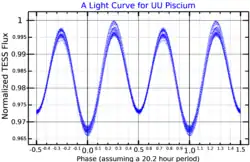| Observation data Epoch J2000.0 Equinox J2000.0 (ICRS) | |
|---|---|
| Constellation | Pisces |
| Right ascension | 00h 14m 58.84021s[2] |
| Declination | +08° 49′ 15.4739″[2] |
| Apparent magnitude (V) | 5.88 (6.10 + ? + 7.72)[3] |
| Characteristics | |
| Spectral type | F0IV + F0: + F[3] |
| Variable type | ELL/DW:[4] |
| Astrometry | |
| Radial velocity (Rv) | 0.9±0.9[5] km/s |
| Proper motion (μ) | RA: +99.42[2] mas/yr Dec.: −23.62[2] mas/yr |
| Parallax (π) | 12.86 ± 1.05 mas[2] |
| Distance | 250 ± 20 ly (78 ± 6 pc) |
| Other designations | |
| Database references | |
| SIMBAD | data |
35 Piscium is a triple star[3] system in the northern constellation Pisces,[6] located about 250 light years away from the Sun. Because it is a variable star, it has been given the variable star designation UU Piscium; 35 Piscium is the Flamsteed designation.[6] This system is faintly visible to the naked eye with a combined apparent visual magnitude of 5.88.[3] It is catalogued as a member of the IC 2391 supercluster by Olin J. Eggen.[7]
In the past the inner pair, designated component A,[7] has been described as an eclipsing binary system, showing a primary minimum of 6.05 and a secondary minimum of 6.04. They have an orbital period of 0.841658 days, zero eccentricity, and an inclination of 19 degrees. However, Bruno Cester argued that the apparent eclipses are not real, and were caused by seeing different portions of distorted-shaped stars in a near contact binary system.[8] As of 2017, it is classified as a rotating ellipsoidal variable and possibly a W Ursae Majoris-type system, although not in physical contact.[4] The components of this pair appear to be equal,[7] with stellar classifications of F0 V[9] or F0 IV.[10]
The magnitude 7.72 tertiary member, designated component B, lies at an angular separation of 11.464″ from the main pair.[3]
References
- ↑ "MAST: Barbara A. Mikulski Archive for Space Telescopes". Space Telescope Science Institute. Retrieved 8 December 2021.
- 1 2 3 4 5 van Leeuwen, F. (2007). "Validation of the new Hipparcos reduction". Astronomy and Astrophysics. 474 (2): 653–664. arXiv:0708.1752. Bibcode:2007A&A...474..653V. doi:10.1051/0004-6361:20078357. S2CID 18759600.
- 1 2 3 4 5 Eggleton, P. P.; Tokovinin, A. A. (2008). "A catalogue of multiplicity among bright stellar systems". Monthly Notices of the Royal Astronomical Society. 389 (2): 869–879. arXiv:0806.2878. Bibcode:2008MNRAS.389..869E. doi:10.1111/j.1365-2966.2008.13596.x. S2CID 14878976.
- 1 2 Samus, N. N.; et al. (2017). "General Catalogue of Variable Stars". Astronomy Reports. 5.1. 61 (1): 80–88. Bibcode:2017ARep...61...80S. doi:10.1134/S1063772917010085. S2CID 125853869.
- ↑ Wilson, Ralph Elmer (1953). "General catalogue of stellar radial velocities". Carnegie Institute Washington D.C. Publication. Carnegie Institution of Washington. Bibcode:1953GCRV..C......0W.
- 1 2 3 "chi Per". SIMBAD. Centre de données astronomiques de Strasbourg. Retrieved 2019-03-24.
- 1 2 3 Eggen, Olin J. (December 1995). "Reality Tests of Superclusters in the Young Disk Population". Astronomical Journal. 110: 2862. Bibcode:1995AJ....110.2862E. doi:10.1086/117734.
- ↑ Schmidtke, P.C. (1980). "The Case for UU Piscium". International Amateur-Professional Photoelectric Photometry Communication. 2: 19–20. Bibcode:1980IAPPP...2...19S.
- ↑ Levato, H. (January 1975), "Rotational velocities and spectral types for a sample of binary systems", Astronomy and Astrophysics Supplement Series, 19: 91–99, Bibcode:1975A&AS...19...91L
- ↑ Cowley, Anne; Fraquelli, Dorothy (February 1974). "MK Spectral Types for Some Bright F Stars". Publications of the Astronomical Society of the Pacific. 86 (509): 70. Bibcode:1974PASP...86...70C. doi:10.1086/129562.
